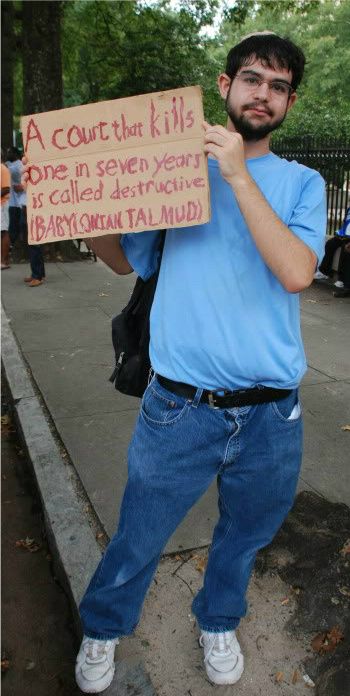Amtrak, founded after the collapse of the rail industry (especially the passenger rail industry) in the 1950s and 1960s to continue to provide passenger rail service, has been a major whipping boy for Congressional Republicans pretty much since it was founded.
Freight rail has become profitable again, and if energy prices go up, it should do even better. But passenger rail is still barely ridden in this country, with the exception of the Northeast corridor.
The reason is simple: it's not easy to get people to take the train when it cannot even be competitive in terms of time with the personal automobile, much less with air travel (for limited distances; due to air travel's major overhead and, in many places, major delays), and if you cannot fill the trains, you have also got the problem of costs.
And often, the train is often not even competitive (much less beating) the peronal automobile in terms of travel time.
Below, the mean speed of a train on various tracks throughout the country according to their Amtrak timetables; when lines intersect with the Northeast corridor, I leave the part on the corridor out. When certain parts of a line are far slower, I note that as well. Specifically, I put the mean speed when we discount the time spent waiting at stations (when that time is specified in the schedule), just to point out how bad things are; these are speeds over time when the train is moving (minus I suppose some number of minutes at the brief stops)
I'm ignoring the few lines that go across national lines, because customs slows things down there.
St. Albans, Vermont, to Albany, NY: 40.2
Albany to New York Penn, 56.4.
Rutland, Vermont to Albany, NY 32.4d (15 minute wait in Albany)
Rouses Point, New York to Albany, NY 34.2
Bellingham, WA to Seattle, WA: 38
Seattle, WA to Portland, OR: 53.4
Portland, OR to Eugene, OR: 50.9
Washington, DC to Raleigh, NC: about 53
(having trouble with the rest of the route until Jacksonville, FL along the east coast, but mean speed seem to remain in low-to-mid 50s)
Jacksonville, FL to Tampa, FL: 48.4
Winter Haven, FL to Miami, FL: 47.9
Chicago, IL to Omaha, NE: 58.9
Omaha, NE to Denver, CO: 56.6
Denver, CO to Salt Lake City, UT: 38
Salt Lake City, UT to Emeryville, CA: 49.8
San Jose, CA to Sacramento, CA: 43.1
Washington, DC to Cumberland, MD: 46.3
Cumberland, MD to Pittsburgh, PA: 34.8
Pittsburgh, PA to Cleveland, OH: 48.3
Cleveland, OH to Toledo, OH: 49.8
Toledo, OH to Chicago, IL: 53.4
Washington, DC to Clifton Forge, VA (43.1)
And it goes on like that, basically maxing at the low 50s as a mean speed when moving, except on the incredibly flat, straight Chicago to Omaha stretches and such; also, I believe the Albany to NYC tracks may have had some improvements done.
Except, of course, on the Northeast corridor, where NYC to Washington is 65.9 mph on average, better than a car can do straight without speeding.
I cannot find the distance for the track from NYC to Boston, so I can't provide an estimate there.
The point is, though that even 110 mph max track would be good enough to significantly increase ridership; it worked on the line between Philly and Harrisburg, where the 59.4 mph mean speed on the Keystone route has greatly increased ridership.
It'll work on the other areas as well. And of course, California and to a lesser extent Florida will be revolutionized.
This is why the work being done to get even semi-high train speeds (and genuine high train speeds in Florida and especially California)
skip to main |
skip to sidebar

Protest Vigil for Troy Davis
Pages
Picture of Me

Protest Vigil for Troy Davis
Blog Archive
-
▼
2010
(94)
-
▼
January
(27)
- How Far Massachusetts Has Come on Abortion Rights
- Anti-Semitic Banker Gold-Digger Gretta Duisenberg
- Ma'an News Agency (Jan 20): Mahmoud al-Mahbuh Dies...
- Why Amtrak Hasn't Gotten Riders, and How That Will...
- You Owe Me Two Hours, Census Bureau
- All Aboard! Department of Transportation Issued "H...
- Laila Abdelaziz: Obama's Questioner about Israel i...
- A Little over 1% of DC Residents are Homeless
- Silence from European Press and "Human Rights Orga...
- Shapira and Nafa both belong in Jail
- Shmuley Boteach Comes out in Favor of Gay Marriage?
- All significant U.S. Orthodox Rabbinates Together ...
- "Tefillin Bomber" Diverts Louisville-Bound Flight ...
- Newspapers in the Google News Archive
- Real Question: How does Rav Shteinman have that ki...
- On Jared Malsin-A Look at His Past Work
- Balad Dismisses MK Said Naffaa-for contact with Le...
- Democrats Hold All 10 NOVA seats in VA Senate
- Google Considers Pulling Out of China
- NAACP hypocritical regarding 2010 Census 'Negro' C...
- Kerry Picket Errs Regarding Citizenship Question i...
- The 2010 Census: Short Forms for Everybody, and Ga...
- Haredim Should Do the Jobs 'Israelis Won't Do' Ins...
- An Open Letter to Jonathan Rosenblum
- Haredi Women Getting Abortions?
- Are Haredim Planning to Expand their Shabbos rioting?
- Bravo to the anonymous 60-year old Tear Gas (Peppe...
-
▼
January
(27)
